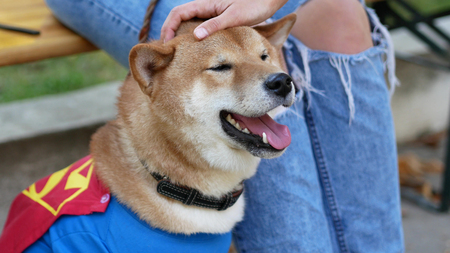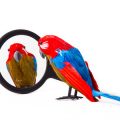Understanding Why Fur Gets Matted
If you’ve ever run your fingers through your dog’s coat and found tangled, clumpy fur, you’re not alone. Matted fur is a common problem for many pet parents, especially in certain breeds or during specific seasons. Let’s break down the main reasons why your dog’s fur can become matted and what factors play a role.
Common Causes of Matted Fur in Dogs
| Cause | Description |
|---|---|
| Shed Undercoat | Dogs naturally shed their undercoat, especially during seasonal changes. If the loose hair isn’t brushed out regularly, it can get trapped and tangle with the topcoat, leading to mats. |
| Moisture | When your dog gets wet from rain, swimming, or baths and isn’t dried thoroughly, the dampness can cause fur to stick together and form mats as it dries. |
| Activity Level | Active dogs that love rolling around outside or running through bushes are more likely to pick up debris. Dirt, twigs, or grass can get caught in their coat and start tangling the fur. |
| Breed-Specific Coat Types | Certain breeds have hair that is more prone to matting. For example, Poodles, Doodles, Shih Tzus, and Cocker Spaniels have curly or fine hair that can easily become tangled if not cared for properly. |
How Mats Affect Your Dog’s Comfort
Matted fur isn’t just a cosmetic issue—it can actually be uncomfortable or even painful for your dog. Mats pull on sensitive skin, restrict movement, and trap dirt and moisture close to the skin, which may lead to irritation or infections. That’s why understanding the causes is the first step in keeping your pup happy and healthy.
2. Recognizing the Signs and Risks of Matted Coats
How to Spot Matted Fur on Your Dog
Matted fur doesn’t just look messy—it can be uncomfortable and even painful for your dog. Mats often develop in areas with a lot of friction, like behind the ears, under the collar, armpits, and around the tail. Here are some common signs your dog might have matted fur:
- Lumps or tangles in the coat that you can’t brush through
- Your dog flinches or pulls away when touched in certain spots
- Red or irritated skin visible through parted hair
- Unpleasant odor coming from tangled areas
- Behavioral changes, like increased scratching or licking
Why Matted Fur Is More Than Just a Cosmetic Issue
Matted fur isn’t just unsightly; it can seriously affect your dog’s health and happiness. When mats get tight, they pull on your dog’s skin and make simple movements painful. Here’s how matted fur impacts your pup:
| Problem | Impact on Your Dog |
|---|---|
| Tugging on Skin | Mats pull at the skin, causing discomfort and sometimes even bruising. |
| Restricted Movement | Tight mats can limit flexibility, making it hard for your dog to walk or play. |
| Skin Infections | Mats trap moisture and dirt, creating an environment where bacteria thrive. |
| Hotspots & Sores | Irritated skin beneath mats may become raw, leading to painful sores called hotspots. |
Areas Most Prone to Matting
- Behind the ears
- Under the collar or harness
- Between the legs and armpits
- Along the belly and hindquarters
- Around the tail and rear end
When to Get Professional Help
If mats cover a large area or are close to the skin, it’s best to contact a professional groomer or your veterinarian. Trying to cut out severe mats at home can lead to accidental cuts or worsen your dogs stress. Early action keeps your pet comfortable and healthy!
![]()
3. Home Grooming Tools and Techniques
Choosing the Right Tools for Matted Fur
When dealing with matted fur, having the right grooming tools at home makes all the difference. Here’s a quick guide to some of the most effective items you can use:
| Tool | Best For | How to Use |
|---|---|---|
| Slicker Brush | Everyday brushing and loosening small tangles | Gently brush in the direction of hair growth; avoid using too much pressure on sensitive skin. |
| Wide-Tooth Comb | Detangling and working through larger knots | Start at the tip of the fur and work towards the base, section by section. |
| De-matting Tool/Rake | Tough mats that can’t be brushed out easily | Use short strokes to carefully break up mats; always support your dog’s skin underneath. |
| Detangling Spray | Softening tangles before brushing or combing | Mist lightly over matted areas and let it sit a minute before working through the knot. |
| Blunt-Tip Scissors (for emergencies) | Mats close to the skin that cannot be removed otherwise | If you must cut, slide a comb between skin and mat first to protect your dog. |
Step-by-Step: How to Safely Remove Mats at Home
- Stay Calm: If your dog senses stress, grooming will be harder. Offer treats and talk softly throughout.
- Prep the Area: Choose a quiet spot with good lighting. Have your tools within reach.
- Use Detangling Spray: Lightly mist any matted areas. This helps loosen knots and makes brushing less painful.
- Slicker Brush First: Start with a slicker brush to remove loose fur around the mat. Don’t pull hard—gentle is best!
- Tackle the Mat: Hold the base of the mat close to your dog’s skin to reduce pulling. Use a wide-tooth comb or de-matting tool, starting from the tips and working inward slowly.
- Praise and Reward: Give treats after each small win! This keeps your pup relaxed and makes future grooming easier.
- If It’s Too Tough: If you can’t safely remove a mat without hurting your dog, call your groomer or vet for help.
Tips for Keeping Your Dog Relaxed During Grooming
- Groom after exercise when your dog is calmer.
- Use plenty of treats or favorite toys as distractions.
- Take breaks if either of you feels stressed.
- Avoid rushing—the more positive experiences, the easier it will get!
- If your dog is anxious, try playing soft music or using calming sprays made for pets.
Quick Reference: Do’s and Don’ts for Home Dematting
| Do’s | Don’ts |
|---|---|
| – Go slow and be patient – Support your dog’s skin while working – Use proper tools – Reward good behavior often |
– Never pull or yank on mats – Don’t use sharp scissors near skin – Avoid wetting mats before detangling – Don’t force it—ask for pro help if needed |
The right tools and gentle techniques will not only make dematting safer but also help create a positive bonding experience with your dog during grooming sessions.
4. When to Seek Professional Help
If you’re struggling with your dog’s matted fur, it’s important to know when it’s time to call in the pros. Sometimes, mats are just too tough or risky to handle at home. Here’s how to tell if you need help from a groomer or veterinarian:
Signs You Should See a Professional
| Situation | Who to Call | Why |
|---|---|---|
| Severe matting all over the coat | Professional Groomer | They have the right tools and experience to safely remove tight mats. |
| Your dog shows pain (whining, biting, flinching) | Veterinarian | Pain could mean skin damage or infection under the mats. |
| Redness, sores, or strange smells from the skin | Veterinarian | This could be a sign of an infection that needs medical care. |
| Mats near sensitive areas (ears, genitals, armpits) | Professional Groomer/Veterinarian | These spots are delicate and easy to injure without proper training. |
| You’ve tried brushing but can’t get mats out safely | Professional Groomer | Trying too hard at home can hurt your dog or make things worse. |
What Professionals Can Do That You Can’t at Home
- Special Tools: Groomers use clippers and detangling sprays designed for serious mats.
- Sedation: Vets can safely sedate anxious or painful dogs if needed for mat removal.
- Treating Skin Issues: Veterinarians can treat wounds or infections found under mats.
- Expert Handling: Professionals know how to keep your dog calm and comfortable during the process.
Don’t Wait Too Long!
If you notice any of these signs, reaching out early can prevent more serious health problems for your pup. A professional will help get your dog’s coat back on track—and keep them feeling their best!
5. Preventing Future Mats
Regular Grooming Routines
Keeping your dog’s coat healthy and free from mats starts with a consistent grooming routine. Even if you have a busy American lifestyle, setting aside just a few minutes each day can make a big difference. Brushing your dog daily helps prevent tangles and removes loose fur before it becomes matted. Choose grooming times that fit easily into your schedule—like during TV time or right after walks.
Recommended Grooming Frequency by Coat Type
| Coat Type | Recommended Brushing |
|---|---|
| Short-haired (e.g., Beagle, Boxer) | 1-2 times per week |
| Medium-haired (e.g., Golden Retriever, Collie) | 3-4 times per week |
| Long-haired/Curly (e.g., Poodle, Shih Tzu) | Daily |
Choosing the Right Products for Your Dog’s Coat
The right tools and products can make grooming more effective and comfortable for both you and your dog. Use brushes and combs designed for your dog’s specific coat type. Detangling sprays or conditioners help reduce friction and make brushing easier, especially for dogs prone to mats. Many pet stores in the U.S. offer a variety of coat care products tailored to different breeds and needs.
Essential Grooming Tools
| Tool/Product | Best For |
|---|---|
| Slicker Brush | Removing loose hair and small mats in medium to long coats |
| Wide-Tooth Comb | Tackling larger tangles in thick or curly coats |
| Detangling Spray | Easing out knots and preventing future mats |
| Pins Brush | Sensitive skin or finishing after dematting |
| Nail Clippers/Grinder | Total paw care as part of overall grooming routine |
Lifestyle Tips for Busy Pet Parents in America
If you’re juggling work, family, and other commitments, keeping up with your dog’s grooming might seem challenging. Try these practical tips to make it easier:
- Create a Schedule: Set reminders on your phone or calendar for regular brushing sessions.
- Mobile Groomers: Consider hiring mobile groomers who come to your home—very popular in many U.S. cities.
- Doggy Daycare Add-ons: Some daycare facilities offer grooming services while your dog plays.
- Kid Helpers: If you have children, involve them in simple tasks like brushing under supervision—it can be a fun family activity!
- Keep Supplies Handy: Store brushes, sprays, and wipes in an easy-to-reach spot so you’re always ready for quick touch-ups.
- Paw-walk Touch-ups: Use post-walk time to quickly check for burrs or tangles, especially after hikes or park visits common in American neighborhoods.
A Healthy Coat Means a Happy Dog!
A little prevention goes a long way toward keeping your dog comfortable and mat-free. With regular care, the right tools, and some smart scheduling, even the busiest pet parents can enjoy cuddle time with their clean, happy pup.


